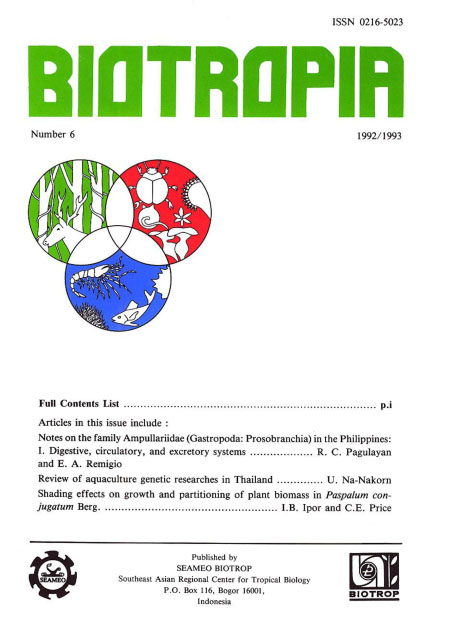
SEAMEO BIOTROP
Southeast Asian Ministers of Education Organization
768
views
Tags
EFFECTS OF THE HEAVY METAL, ZINC, ON THE FRESHWATER FISH TILAPIA NILOTICA L.
24 May 2019 - 02:54 pm (6 year ago)
Content Language : English
Content Language : English

Category :
Applied Science
Gills, gonads, and blood of Tilapia nilotica exposed to different concentrations of zinc sulfate (ZnSO4.
7H2O) exhibited histological effects. Gills of posthatch larvae exposed chronically for 21 days to 2 ppm zinc
sulfate and fingerlings to 10 ppm sublethal zinc concentrations exhibited hyperplasia that resulted in fusion of
adjacent secondary gill lamellae. The same effects were observed in 4-hour short-term exposure to 30 ppm
lethal dose.
Posthatch larvae subjected to 2 and 5 ppm sublethal levels of zinc for 30 days retained
undifferentiated gonads with differentiation with oogonial proliferation. Ovaries of control fish
demonstrated healthy oocyte growth and other normal histological features after 57 days. In contrast, ovaries in
treated groups exhibited excessive amounts of connective tissue, hyperemia and markedly reduced oocyte number.
Oocytes had wavy irregular surface outlines. Deviation from normal was observed to be dose dependent. In
juvenile tilapia, spermatogenesis was observed in control testes. Testes of zinc-exposed fish, on the other hand,
remained immature. Hyperemia was markedly pronounced in both testes and ovary after 90 days exposure to
zinc.
Blood of Tilapia nilotica fingerlings exposed to sublethal concentrations of 2, 5, and 10 ppm zinc for 30,
60, and 90 days exhibited anisocytosis and poikilocytosis. There was an increase in hematocrit values in
zinc-reared fish which, however, reverted to control/near control levels at day 90. Hemoglobin values were
inversely proportional to the level of zinc in the rearing water. The marked reduction in hemoglobin values in
fish reared at the higher zinc concentrations of 5 and 10 ppm suggests the development of some degree of anemia
which is also supported by the observations of anisocytosis and poikilocytosis.
7H2O) exhibited histological effects. Gills of posthatch larvae exposed chronically for 21 days to 2 ppm zinc
sulfate and fingerlings to 10 ppm sublethal zinc concentrations exhibited hyperplasia that resulted in fusion of
adjacent secondary gill lamellae. The same effects were observed in 4-hour short-term exposure to 30 ppm
lethal dose.
Posthatch larvae subjected to 2 and 5 ppm sublethal levels of zinc for 30 days retained
undifferentiated gonads with differentiation with oogonial proliferation. Ovaries of control fish
demonstrated healthy oocyte growth and other normal histological features after 57 days. In contrast, ovaries in
treated groups exhibited excessive amounts of connective tissue, hyperemia and markedly reduced oocyte number.
Oocytes had wavy irregular surface outlines. Deviation from normal was observed to be dose dependent. In
juvenile tilapia, spermatogenesis was observed in control testes. Testes of zinc-exposed fish, on the other hand,
remained immature. Hyperemia was markedly pronounced in both testes and ovary after 90 days exposure to
zinc.
Blood of Tilapia nilotica fingerlings exposed to sublethal concentrations of 2, 5, and 10 ppm zinc for 30,
60, and 90 days exhibited anisocytosis and poikilocytosis. There was an increase in hematocrit values in
zinc-reared fish which, however, reverted to control/near control levels at day 90. Hemoglobin values were
inversely proportional to the level of zinc in the rearing water. The marked reduction in hemoglobin values in
fish reared at the higher zinc concentrations of 5 and 10 ppm suggests the development of some degree of anemia
which is also supported by the observations of anisocytosis and poikilocytosis.

This work is licensed under a Creative Commons Attribution-NonCommercial-NoDerivatives 4.0 International License.
